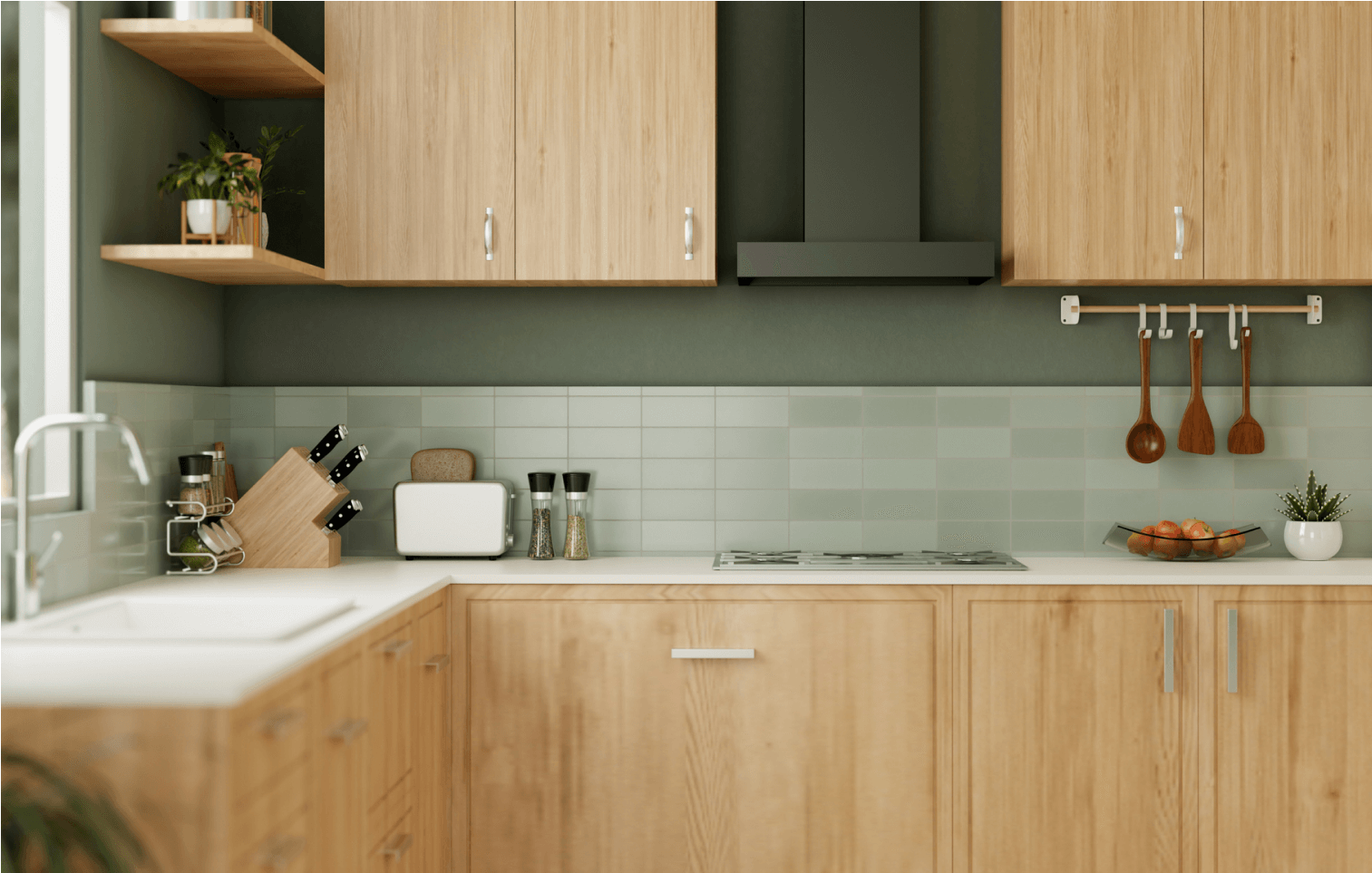Cleaning Wood Cabinets: Preserve Your Home With These Natural Methods

Wood cabinets take a lot of wear and tear, especially in the kitchen.
They’re opened and closed multiple times a day, and quite often become the target of hot grease and food splatters.
This is why regular cleaning with wood-safe products is essential to preserve their shine and prevent buildup.
In this article, you’ll learn three methods for cleaning wood cabinets using human-safe products and common household staples without the need for harsh chemicals.
Important note: Always test a small area to make sure the wood finish is not impacted by cleaners.
Materials Needed
Before cleaning your wood cabinets, gather whatever you have of the following supplies:
-
HEPA vacuum
-
Branch Basics Concentrate
-
Branch Basics All-Purpose
- Distilled white vinegar
- Liquid castile soap
- Baking soda
- Olive oil
- Club soda
- Water
- Soft-bristle toothbrush or a non-abrasive sponge
- Microfiber cloths
- Bowl
Don't worry, you won't need all these products at once! But they are all effective, low-tox cleaners.
We'll explain how to use them in different combinations next.
3 Methods For Cleaning Wood Cabinets, Naturally
To clean wood cabinets naturally, you can use common household staples like vinegar, baking soda, and liquid castile soap.
Alternatively, you can use a human-safe, natural, plant- and mineral-based cleaning product (hint: Branch Basics).
Here are three natural methods to try while cleaning wood cabinets.
Vinegar Two Ways
Vinegar is an ancient food, medicine, and (believe it or not) cleaner.
The natural acetic acid* found in distilled white vinegar is excellent for removing oily, greasy, and grimy residues often found on wood cabinets.
Here are two methods for cleaning wood cabinets with vinegar:
Method #1: Distilled White Vinegar + Water
- Create a cleaning mixture of equal parts warm water and vinegar. Add the solution to a spray bottle.
- Note: If your wood cabinets are heavily soiled, add a few drops of Branch Basics Concentrate, or your favorite human-safe dish soap to the spray bottle.
- Open the wood cabinets and remove all items. Use a HEPA vacuum to dust the interior and exterior.
- No HEPA vacuum? No problem. Instead, wipe cabinets with a lightly damp microfiber cloth to remove dust and debris.
- Lightly spray a microfiber with the solution*. Wipe the wood cabinets, inside and out, and let dwell on the surface for 3 minutes.
- Wet a clean microfiber cloth in warm water. Wring the cloth out thoroughly and wipe over the wood cabinets to remove grease and grime.
- Buff with a dry microfiber cloth. Let air dry.
*Note: Do not directly spray wood cabinets to avoid oversaturation of the finish, as too much moisture can cause warping and damage to the finish.
Also, vinegar is not recommended for use on waxed wood or natural shellac. Vinegar dissolves shellac.
If you’re unsure, test the cleaning solution in a small, inconspicuous area of the wood to observe its effects.
Method #2: Distilled White Vinegar + Olive Oil + Water
Use this on wood sealed with a varnish or a polyurethane sealer. Do not use on wood sealed with wax or oil.
- Open the wood cabinets and remove all items.
- Use a HEPA vacuum to dust the interior and exterior of all cabinets, or wipe cabinets with a lightly damp microfiber cloth to remove dust and debris.
- Mix 2 tablespoons of olive oil + 5 tablespoons white vinegar + 2 cups warm water in a spray bottle.
- Shake vigorously and spray the microfiber cloth with the solution. Always shake before use.
- Wipe the cabinets with a soft cloth.
- The vinegar will remove buildup, and the olive oil will leave a shine.
*Important note: Vinegar contains acetic acid, which becomes an eye and lung irritant when sprayed.
Make sure you avoid breathing the fumes and provide good ventilation to clear the air quickly of the acetic acid.
Do not spray vinegar or vinegar solutions around elderly individuals, babies, young children, or those with chronic illnesses.
For more, check out 12 Ways To Use Vinegar In Your Home.
Branch Basics
Branch Basics is an all-in-one, human-safe, ultra-gentle, fragrance-free, plant- and mineral-based cleaning line designed to replace every cleaner and laundry product in your home with just one Concentrate.
Our products can be used in every room, including the kitchen. Check out our Best Human-Safe Kitchen Cleaning Tips for more.
For cleaning wood cabinets, we recommend using our All-Purpose spray, which is gentle enough on wood surfaces but tough on grease and grime.
Note: Because wood is a porous material, never oversaturate it with water or any cleaning solution, as this can cause the wood to warp or damage its finish. Always test Branch Basics on an inconspicuous area of the sealed wood surfaces to make sure the finish is not impacted.
Here’s how to clean wood cabinets using Branch Basics:
- Before you begin cleaning, remove everything from the cabinets and HEPA vacuum, or dust with a damp microfiber cloth. Focus on the interior and exterior of each cabinet.
- Lightly spray a clean microfiber cloth with All-Purpose.
- Wipe down the interior. When dry, replace all items and close the wood cabinets.
- Next, focus on the exterior. Gently scrub the greasy and grimy spots, following the grain, to avoid damaging the wood finish. Also, be sure to wipe down the hardware.
- Use a damp microfiber cloth to wipe away any soapy solution left behind.
- Buff the wood with a dry microfiber cloth to shine your cabinet doors. Let air dry.
Club Soda
Club Soda as a cleaner?! Oh yes. Club Soda can be used as a simple and versatile DIY cleaner for various household chores, including cleaning wood cabinets.
The carbonation helps lift dirt, grease, and grime from the surface.
Here’s how to use club soda to clean wood cabinets:
- Working on one cabinet at a time, open and remove all items. Use a HEPA vacuum to remove crumbs and dust, or dust with a damp microfiber cloth. Focus on both the interior and exterior of each cabinet.
- Dampen a microfiber cloth with club soda and wipe to remove grease and grime.
- Wipe with a clean, damp microfiber to remove residues and prevent sticky buildup from carbonation.
- Move to the next wood cabinet and repeat the process.
How Often Should You Clean Your Wood Cabinets?
To prevent dust, grease, and grime from building up, we recommend wiping down your wood cabinets once a week with a damp microfiber cloth.
Depending upon how soiled your cabinets get over time, a deep clean every 3 to 6 months should be sufficient.
Tips For Preserving Wood Cabinets
Keeping your wood cabinets clean and well-maintained is simple: dust regularly, clean food splatters quickly, and consider using contact paper.
Dust Regularly
Over time, the accumulation of grease, grime, and dust can damage the finish on your wood cabinets, making them look dull.
Regular dusting removes this buildup, preserving the finish and keeping them cleaner.
To dust, run a dry microfiber cloth over your wood cabinets, or try one of these natural dusting spray alternatives.
Remove Splatters Promptly
Promptly removing food splatters from wood cabinets helps prevent permanent staining, avoids damage to the finish, and reduces odors.
Use a damp microfiber cloth, or add a drop of Branch Basics Concentrate to a small dish of warm water and apply directly to the food splatter.
For a full how-to, check out How to Naturally Clean Grease Off Kitchen Cabinets.
Usie Contact Paper
Use contact paper to help keep cabinet shelves safe from water damage and residue buildup.
This is especially helpful inside under-sink cabinets, where small plumbing leaks can occur.
Learn more tips in How To Clean Wood Naturally
Toss the Toxins With Branch Basics
Cleaning wood cabinets is a cinch, especially if you’re using natural products like vinegar, liquid castile soap, Club Soda, or Branch Basics.
Branch Basics is an all-in-one, multi-purpose, human-safe cleaning system that utilizes one natural Concentrate to replace every cleaner and laundry product in the home.
If you’re just starting out with our products, we recommend checking out our Branch Basics Premium Starter Kits (available in refillable plastic or glass).
In the kit, you’ll receive the Concentrate, a full bag of Oxygen Boost, and five reusable bottles to make your own All-Purpose, Bathroom, Streak-Free, Laundry, and Foaming Wash.
Branch Basics products are Made Safe Certified, never tested on animals, and are safe for pets, babies, children, the chronically ill, the elderly, and the chemically sensitive.
For more tips on cleaning and maintaining wood using human-safe products and methods, be sure to check out:

Marilee Nelson
Marilee Nelson is an Environmental Toxins expert who has spent nearly 30 years advocating for the chemically-sensitive and chronically-ill. She is a Board Certified Nutritionist, Certified Bau-Biologist and Bau-Biology Inspector and specializes in Food As Medicine. She has helped thousands of families and individuals identify, heal and recover from toxic exposures and is on a mission to revolutionize the way American families view their health.








